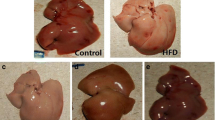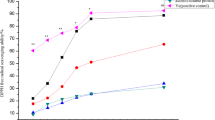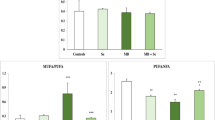Abstract
The AIN-93 reformulation of the AIN-76A rodent diet includes a change in selenium supplement from sodium selenite to sodium selenate to reduce dietary lipid peroxidation. A change to selenate as the standard form of Se in rat diets would render results from previous work using selenite less relevant for comparison with studies using the AIN-93 formulation. To critically examine the rationale for the AIN-93 recommendation, we prepared Torula yeast basal diets patterned as closely as possible after the AIN-93 formulation and supplemented with 0, 0.15 (adequate), or 2.0 (high) mg selenium/kg diet as sodium selenite or sodium selenate. Livers isolated from male Sprague-Dawley rats fed these diets for 15 wk showed no differences in thiobarbituric acid-reactive substances or lipid hydroperoxides measured with the ferrous oxidation in xylenol orange method. Lipids isolated from samples of high-selenate and high-selenite diets showed no differences in conjugated dienes. The addition of selenate or selenite to soybean oil did not result in an altered Oil Stability Index. These results demonstrate that selenate is not less likely than selenite to cause oxidation of other dietary components. Benefits of selenate over selenite in the diets of rodents remain to be demonstrated.
Similar content being viewed by others
References
P. G. Reeves, F. H. Nielsen, and G. C. Fahey, Jr., AIN-93 purified diets for laboratory rodents: final report of the American Institute of Nutrition ad hoc writing committee on the reformulation of the AIN-76A rodent diet, J. Nutr. 123, 1939–1951 (1993).
C. D. Eckhert, M. K. Lockwood, and B. Shen, Influence of selenium on the microvasculature of the retina, Microvasc. Res. 45, 74–82 (1992).
S. C. Vendeland, J. A. Butler, and P. D. Whanger, Intestinal absorption of selenite, selenate, and selenomethionine in the rat, J. Nutr. Biochem. 3, 359–365 (1992).
National Research Council, Selenium in Nutrition, rev. ed., National Academy Press, Washington, DC (1983).
J. Brtko and P. Filipcik, Effect of selenite and selenate on rat liver nuclear 3,5,3′-triiodothyronine (T3) receptor, Biol. Trace Element Res. 41, 191–199 (1994).
J. Brtko, P. Filipcik, S. Hudecova, A. Brtkova, and J. Bransova, Nuclear all-trans retinoic acid receptors: in vitro effects of selenium, Biol. Trace Element Res. 62, 43–50 (1998).
B. P. Sani, J. L. Woodard, M. C. Pierson, and R. D. Allen, Specific binding proteins for selenium in rat tissues, Carcinogenesis 9, 277–284 (1988).
Z. J. Wang, J. Zhou, and A. Peng, Metabolic differences and similarities of selenium in blood and brain of the rat following the administration of different selenium compounds, Biol. Trace Element Res. 33, 135–143 (1992).
National Research Council, Guide for the Care and Use of Laboratory Animals, National Academy Press, Washington, DC (1996).
National Research Council, Nutrient Requirements of Laboratory Animals, National Academy Press, Washington, DC (1995).
American Oil Chemists’ Society, Official Methods and Recommended Practices of the AOCS; Cd 12b-92, 5th ed., American Oil Chemists’ Society, Champaign, IL (1998).
M. Uchiyama and M. Mihara, Determination of malonaldehyde precursor in tissues by thiobarbituric acid test, Anal. Biochem. 86, 271–278 (1978).
W. G. Willmore and K. B. Storey, Antioxidant systems and anoxia tolerance in a freshwater turtle Trachemys scripta elegans, Mol. Cell. Biochem. 170, 177–185 (1997).
Z. Y. Jiang, A. C. Woollard, and S. P. Wolff, Lipid hydroperoxide measurement by oxidation of Fe2+ in the presence of xylenol orange. Comparison with the TBA assay and an iodometric method, Lipids 26, 853–856 (1991).
M. Hermes Lima, W. G. Willmore, and K. B. Storey, Quantification of lipid peroxidation in tissue extracts based on Fe(III) xylenol orange complex formation, Free Radical Biol. Med. 19, 271–280 (1995).
M. J. Christensen, P. M. Cammack, and C. D. Wray, Tissue specificity of selenoprotein gene expression in rats, J. Nutr. Biochem. 6, 367–372 (1995).
R. A. Lawrence and R. F. Burk, Glutathione peroxidase activity in selenium-deficient rat liver, Biochem. Biophys. Res. Commun. 71, 952–958 (1976).
M. J. Christensen, B. L. Nelson, and C. D. Wray, Regulation of glutathione S-transferase gene expression and activity by dietary selenium, Biochem. Biophys. Res. Commun. 202, 271–277 (1994).
W. H. Habig, M. J. Pabst, and W. B. Jakoby, Glutathione S-transferases. The first enzymatic step in mercapturic acid formation, J. Biol. Chem. 249, 7130–7139 (1974).
O. H. Lowry, N. J. Rosebrough, A. L. Farr, and R. J. Randall, Protein measurement with the folin phenol reagent, J. Biol. Chem. 193, 265–275 (1951).
Report of the American Institute of Nutrition ad hoc Committee on Standards for Nutritional Studies, J. Nutr. 107, 1340–1348 (1977).
R. F. Burk and J. M. Lane, Ethane production and liver necrosis in rats after administration of drugs and other chemicals, Toxicol. Appl. Pharmacol. 50, 467–478 (1979).
A. S. Csallany, L. C. Su, and B. Z. Menken, Effect of selenite, vitamin E and N,N′-diphenyl-p-phenylenediamine on liver organic solvent-soluble lipofuscin pigments in mice, J. Nutr. 114, 1582–1587 (1984).
J. J. Dougherty and W. G. Hoekstra, Stimulation of lipid peroxidation in vivo by injected selenite and lack of stimulation by selenate, Proc. Soc. Exp. Biol. Med. 169, 209–215 (1982).
D. Bonnes Taourel, M. C. Guerin, and J. Torreilles, Is malonaldehyde a valuable indicator of lipid peroxidation? Biochem. Pharmacol. 44, 985–988 (1992).
D. R. Janero, Malondialdehyde and thiobarbituric acid-reactivity as diagnostic indices of lipid peroxidation and peroxidative tissue injury, Free Radical Biol. Med. 9, 515–540 (1990).
D. Lapenna and F. Cuccurullo, TBA test and “free” MDA assay in evaluation of lipid peroxidation and oxidative stress in tissue systems [letter; comment], Am. J. Physiol. 265, H1030-H1032 (1993).
B. Halliwell and J. M. C. Gutteridge, Free Radicals in Biology and Medicine, 3rd ed., Oxford University Press, New York (1999).
R. F. Burk, Production of selenium deficiency in the rat, Methods Enzymol. 143, 307–313 (1987).
M. J. Christensen, Selenium diets: deficiency and excess, in Trace Elements in Laboratory Rodents, R. R. Watson, ed., CRC, Boca Raton, FL, pp. 123–132 (1996).
Y. Sun, P-C. Ha, J. A. Butler, B-R. Ou, J-Y. Yeh, and P. Whanger, Effect of dietary selenium on selenoprotein W and glutathione peroxidase in 28 tissues of the rat, J. Nutr. Biochem. 9, 23–27 (1998).
J-Y. Yeh, S. C. Vendeland, Q. Gu, J. A. Butler, B-R. Ou, and P. D. Whanger, Dietary selenium increases selenoprotein W levels in rat tissues, J. Nutr. 127, 2165–2172 (1997).
X. G. Lei, J. K. Evenson, K. M. Thompson, and R. A. Sunde, Glutathione peroxidase and phospholipid hydroperoxide glutathione peroxidase are differentially regulated in rats by dietary selenium, J. Nutr. 125, 1438–1446 (1995).
M. Kotrebai, M. Birringer, J. F. Tyson, E. Block, and P. C. Uden, Selenium speciation in enriched and natural samples by HPLC-ICP-MS and HPLC-ESI-MS with perfluorinated carboxylic acid ion-pairing agents, Analyst 125, 71–78 (2000).
O. A. Levander and R. F. Burk, Seleniuim, in Present Knowledge in Nutrition, 7th ed., E. E. Ziegler and L. J. Filer, Jr. eds., International Life Sciences Institute, Washington, DC, pp. 321 (1996).
Author information
Authors and Affiliations
Additional information
Results included in this paper were presented at the meeting of Experimental Biology 98, San Francisco, CA, April 18–22, 1998, and published in abstract form (Moak, M. A., Johnson, B. L., & Christensen, M. J. [1998] On the AIN-93G recommendation for selenium. FASEB J. 12, A824).
Rights and permissions
About this article
Cite this article
Moak, M.A., Christensen, M.J. Promotion of lipid oxidation by selenate and selenite and indicators of lipid peroxidation in the rat. Biol Trace Elem Res 79, 257–269 (2001). https://doi.org/10.1385/BTER:79:3:257
Received:
Revised:
Accepted:
Issue Date:
DOI: https://doi.org/10.1385/BTER:79:3:257




